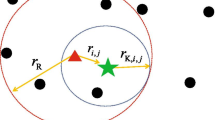Abstract
The performance improvement which results from the use of multiple antennas at each node in a multihop packet radio network is examined. Four transmission strategies based on three previously proposed routing schemes and one new routing scheme, MTP, are studied. It is found that the use of two antennas can improve the performance of all four transmission strategies by about 25% in a Rayleigh fading environment. The transmission strategy based on the MTP routing scheme is shown to be generally superior to those based on the other three routing schemes.
Similar content being viewed by others
References
L. Kleinrock and J. Silvester, Optimum transmission radii for packet radio networks or why six is a magic number, in: Proceedings of IEEE National Telecommunications Conference, Birmingham, Alabama, USA (December 1978) pp. 4.3.1.-4.3.5.
H. Takagi and L. Kleinrock, Optimal transmission ranges for randomly distributed packet radio terminals, IEEE Transactions on Communications COM-32 (March 1984) 246–257.
T. Hou and V. Li, Transmission range control in multihop packet radio networks, IEEE Transactions on Communications COM-34 (January 1986) 38–44.
V. Wong and C. Leung, Effect of Rayleigh fading in a multihop mobile packet radio network with capture, IEEE Transactions on Vehicular Technology 44 (August 1995) 630–637.
W. Jakes, Microwave Mobile Communications (Wiley, New York, 1974).
A. Tanenbaum, Computer Networks (Prentice-Hall, 1996).
M. Barnard, The global positioning system, IEE Review 38 (March 1992) 99–102.
K. Bullington, Radio propagation for vehicular communications, IEEE Transactions on Vehicular Technology VT-26 (November 1977) 295–308.
D. Goodman and A. Saleh, The near/far effect in local ALOHA radio communications, IEEE Transactions on Vehicular Technology VT-36 (February 1987) 19–27.
J. Arnbak and W. Blitterswijk, Capacity of slotted ALOHA in Rayleigh-fading channels, IEEE Journal on Selected Areas in Communications SAC-5 (February 1987) 261–269.
V. Wong and C. Leung, Performance improvement in a multihop packet radio network using multiple antennas, in: IEEE GLOBECOM '94 Conference, San Francisco, CA, USA (November 1994) pp. 1701–1706.
J. Zander, Slotted ALOHA multihop packet radio networks with directional antennas, Electronics Letters 26 (December 1990) 2098–2100.
R. Larsen and M. Marx, An Introduction to Mathematical Statistics and Its Applications (Prentice-Hall, 1981).
P.G. Moore and E.A.C. Shirley, Standard Statistical Calculations (Wiley, New York, 1972).
Author information
Authors and Affiliations
Rights and permissions
About this article
Cite this article
Wong, V., Leung, C. Diversity reception in a multihop packet radio network. Mobile Networks and Applications 5, 39–47 (2004). https://doi.org/10.1023/A:1019127721878
Issue Date:
DOI: https://doi.org/10.1023/A:1019127721878




